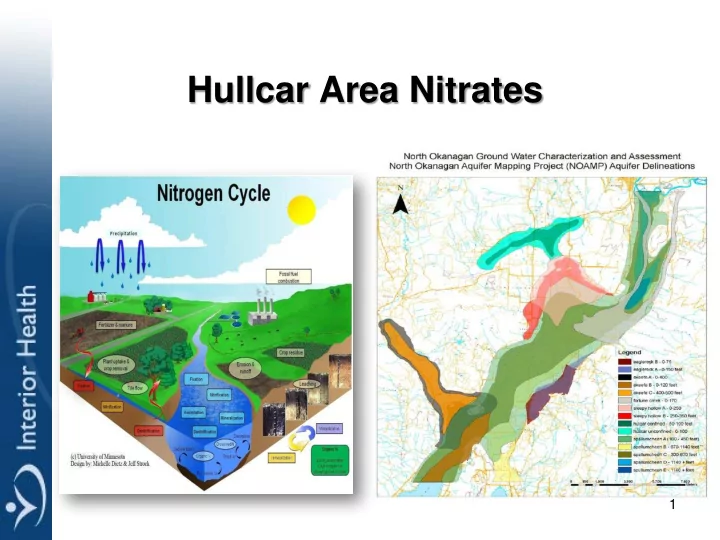

Hullcar Area Nitrates 1
Introduction Dr. Kamran Golmohammadi Rob Birtles Medical Health Officer, IHA Environmental Health Officer, IHA Preventive Medicine Specialist, and Team Leader, Small Water Infrastructure Clinical Faculty at UBC Faculty of Medicine 2
Interior Health Mandate Public Health Act Drink Water Protection Act • Purpose: given the MHO the • Purpose: Principally set out powers to prevent Health requirements for water system Hazards. operators. • Enables legislation on food • Also, provides powers to service, public pools, bio investigate drink water health solids … hazards and prevent harm to the public. 3
Hullcar Area Aquifers • The Hullcar area has two aquifers that over lay each other. • 103 high vulnerablity ~ 14 km 2 , shallow • 102 low vulnerability ~ 14 km 2, deeper.
103Aquifer Boundary
103 Aquifer + Hullcar Area Wells
Hullcar Aquifer Water Quality 7
Nitrates sources • Lawn fertilization • Septic systems • Atmospheric • Farming – Crop fertilization, manure stock piling…
Adverse Health Effects of High Nitrate Ingestion • Short-term • Long-term
Short-term exposure • Infants less than 6 months are at highest risk • Pregnant women are also sensitive • Those with reduced oxygen distribution capacity in their body, e.g. Anemia, Abnormal Hemoglobin, Heart Disease, and Lung Disease
Long-term exposure The studies in which sodium nitrate was administered either in drinking water or in diet to rodents showed that nitrate has a low chronic toxicity.
Long-term exposure • There is no clear evidence of carcinogenicity from nitrate or nitrite in humans. • But cancer risk may exist under conditions of endogenous nitrosation of ingested nitrate and/or nitrite* *The International Agency for Research on Cancer (IARC) in 2010 has classified “ingested nitrate or nitrite under conditions that result in endogenous nitrosation” as probably carcinogenic to humans.
Common sources of Nitrate and Nitrite • Many vegetables & fruits contain high Nitrate (200 to 2500 mg/kg), lettuce, spinach, red beets, fennel, cabbage, parsley, carrots, celery, potatoes, cucumbers, radishes and leeks (higher levels in pickled and fermented vegetables). • Cured meat*: High levels of nitrate and nitrite, (preservative) • Nitrate at levels of up to 945 mg/kg • Nitrite at levels of up to 64 mg/kg * Health Canada has limited the amount of nitrite and nitrate that can be added to meat products to 200 mg/kg
In Summary • In short-term, infants less than 6 months are at the highest risk for high nitrate ingestion. • Our understanding of long-term health effects of high nitrate in drinking water is limited. • Health Canada will continue to “monitor new research in this area & recommend any change to the guideline that it deems necessary”.
Thank You Questions
Recommend
More recommend